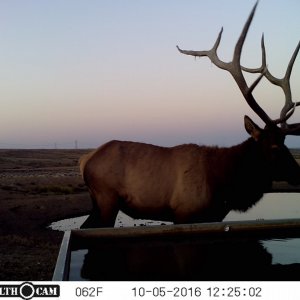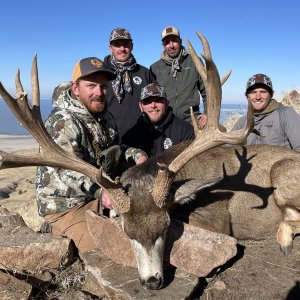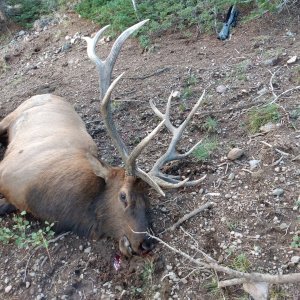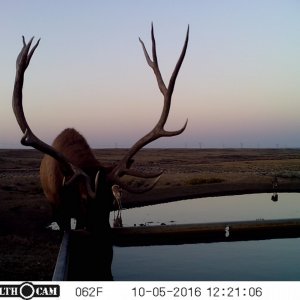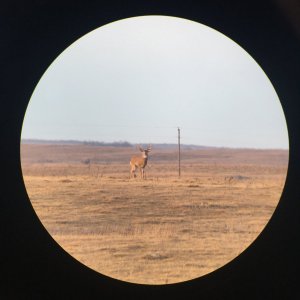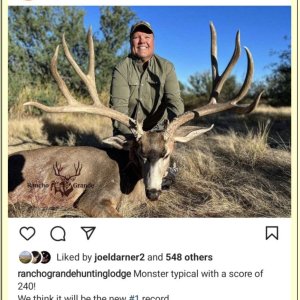T
TFinalshot
Guest
I'm not saying, I'm just saying. . . .
SALT LAKE CITY
Deseret Morning News, Thursday, April 26, 2007
Funds for wildlife refuges are drying up
Group says budget cuts have put sites 'in peril'
By Joe Bauman
Deseret Morning News
Two of the three national wildlife refuges in Utah are so underfunded that supposedly "permanent" positions are not being filled. The backdrop is that most of the 520-plus refuges managed by the National Wildlife Service are strapped for money.
"Restoring America's Wildlife Legacy 2007," a report issued Wednesday by a coalition of advocacy groups called Cooperative Alliance for Refuge Enhancement (CARE), says Congress provided modest funding increases from 1998 until 2003. But later, "subsequent budget cuts have put the refuge system in peril."
Among a host of groups in CARE are the American Birding Association, American Fisheries Society, Defenders of Wildlife, Ducks Unlimited Inc., National Audubon Society, National Rifle Association, the Wilderness Society and Trout Unlimited.
"Years of inadequately funding our nation's wildlife refuges have put the viability of the refuge system at risk," said Maribeth Oakes of the Wilderness Society.
CARE recommends that $765 million in operation and maintenance funding be appropriated "to adequately address the fiscal crisis facing the National Wildlife Refuge System."
It says the present year's budget is half that much. Just to keep pace with increasing expenses, the budget needs a $15 million boost, it adds.
David Eisenhauer, Fish and Wildlife Service spokesman in Washington, D.C., said funding for the refuge system increased from about $300 million a year in 2001 to about $383 million. Although that seems like an impressive 28 percent boost, much of the additional money went for security at the country's "borderlands" and to combat invasive weed species.
"The operational budget hasn't kept pace with increases" in rising salaries and operating costs, he said. Congress ordered raises for federal employees but then kept the F&WS operating budget flat. As a result, fewer positions can be filled.
The Fish and Wildlife Service has been saying that it needs about $15 million more per year in additional operating funds.
Each of the agency's regions has studied its work force to see which staff positions won't be filled should a person retire or move to another job. The purpose, he said, is "to take these dollars and move them to the field. ...
"That's just to continue to provide the wildlife habitat we need" and to carry out other responsibilities of the refuge system.
Dean Rundle, F&WS program supervisor for refuges in Utah, Montana and Wyoming, based in Lakewood, Colo., said that in the eight states of Region 6, the agency has not filled about 43 permanent positions.
These posts were not filled in Utah when they became vacant:
? At Ouray National Wildlife Refuge, 30 miles southwest of Vernal, about 11,987 acres, including a 12-mile stretch of the Green River set aside for migratory birds: "They have a maintenance worker and an administration position vacant that are not being filled," Rundle said.
? At Fish Springs National Wildlife Refuge, 17,992 acres with marshlands amounting to about 10,000 acres, located near Dugway Proving Ground in the western desert: "The system manager job at Fish Springs was vacated and not filled, so Fish Springs Refuge is down to only four employees now," Rundle said.
If optimal funding were available, the refuge would also have a wildlife biologist and a biological technician, he added.
Ideally, Rundle said, "they would have an assistant manager for the Colorado River Wildlife Management Area." This is a management area of 955 acres (as of 2001) of private land on the Green River, held as conservation easements with willing landowners.
The easements, intended to protect endangered fish, are located in Utah and Colorado in the vicinity of Dinosaur National Monument.
Besides positions not filled, refuges have unmet needs like roofs and equipment that should be replaced, and new construction.
According to Rundle, Utah's premier refuge ? Bear River Migratory Bird Refuge, 74,000 acres of marshland near Brigham City ? has suffered no position losses. Besides seasonal part-time workers, the refuge has 11 employees.
"The Bear River's a high priority for us," he said.
Still, the refuge's Web site, www.fws.gov/bearriver, carries this notice: "The road construction on Forest Street that had been scheduled for the summer of 2007 has been postponed."
An F&WS regional "Workforce Plan," prepared in February and released by the alliance, lists all three Utah refuges as targeted for staff reductions, among 42in the region.
Three positions that had been filled in Utah have been abolished, with another slated to be lost by the end of Fiscal Year 2009.
Why hasn't Congress given wildlife refuges more money?
"We had a recession, and we have a war to be fought," Rundle said, "and Congress has a lot of challenges there."
SALT LAKE CITY
Deseret Morning News, Thursday, April 26, 2007
Funds for wildlife refuges are drying up
Group says budget cuts have put sites 'in peril'
By Joe Bauman
Deseret Morning News
Two of the three national wildlife refuges in Utah are so underfunded that supposedly "permanent" positions are not being filled. The backdrop is that most of the 520-plus refuges managed by the National Wildlife Service are strapped for money.
"Restoring America's Wildlife Legacy 2007," a report issued Wednesday by a coalition of advocacy groups called Cooperative Alliance for Refuge Enhancement (CARE), says Congress provided modest funding increases from 1998 until 2003. But later, "subsequent budget cuts have put the refuge system in peril."
Among a host of groups in CARE are the American Birding Association, American Fisheries Society, Defenders of Wildlife, Ducks Unlimited Inc., National Audubon Society, National Rifle Association, the Wilderness Society and Trout Unlimited.
"Years of inadequately funding our nation's wildlife refuges have put the viability of the refuge system at risk," said Maribeth Oakes of the Wilderness Society.
CARE recommends that $765 million in operation and maintenance funding be appropriated "to adequately address the fiscal crisis facing the National Wildlife Refuge System."
It says the present year's budget is half that much. Just to keep pace with increasing expenses, the budget needs a $15 million boost, it adds.
David Eisenhauer, Fish and Wildlife Service spokesman in Washington, D.C., said funding for the refuge system increased from about $300 million a year in 2001 to about $383 million. Although that seems like an impressive 28 percent boost, much of the additional money went for security at the country's "borderlands" and to combat invasive weed species.
"The operational budget hasn't kept pace with increases" in rising salaries and operating costs, he said. Congress ordered raises for federal employees but then kept the F&WS operating budget flat. As a result, fewer positions can be filled.
The Fish and Wildlife Service has been saying that it needs about $15 million more per year in additional operating funds.
Each of the agency's regions has studied its work force to see which staff positions won't be filled should a person retire or move to another job. The purpose, he said, is "to take these dollars and move them to the field. ...
"That's just to continue to provide the wildlife habitat we need" and to carry out other responsibilities of the refuge system.
Dean Rundle, F&WS program supervisor for refuges in Utah, Montana and Wyoming, based in Lakewood, Colo., said that in the eight states of Region 6, the agency has not filled about 43 permanent positions.
These posts were not filled in Utah when they became vacant:
? At Ouray National Wildlife Refuge, 30 miles southwest of Vernal, about 11,987 acres, including a 12-mile stretch of the Green River set aside for migratory birds: "They have a maintenance worker and an administration position vacant that are not being filled," Rundle said.
? At Fish Springs National Wildlife Refuge, 17,992 acres with marshlands amounting to about 10,000 acres, located near Dugway Proving Ground in the western desert: "The system manager job at Fish Springs was vacated and not filled, so Fish Springs Refuge is down to only four employees now," Rundle said.
If optimal funding were available, the refuge would also have a wildlife biologist and a biological technician, he added.
Ideally, Rundle said, "they would have an assistant manager for the Colorado River Wildlife Management Area." This is a management area of 955 acres (as of 2001) of private land on the Green River, held as conservation easements with willing landowners.
The easements, intended to protect endangered fish, are located in Utah and Colorado in the vicinity of Dinosaur National Monument.
Besides positions not filled, refuges have unmet needs like roofs and equipment that should be replaced, and new construction.
According to Rundle, Utah's premier refuge ? Bear River Migratory Bird Refuge, 74,000 acres of marshland near Brigham City ? has suffered no position losses. Besides seasonal part-time workers, the refuge has 11 employees.
"The Bear River's a high priority for us," he said.
Still, the refuge's Web site, www.fws.gov/bearriver, carries this notice: "The road construction on Forest Street that had been scheduled for the summer of 2007 has been postponed."
An F&WS regional "Workforce Plan," prepared in February and released by the alliance, lists all three Utah refuges as targeted for staff reductions, among 42in the region.
Three positions that had been filled in Utah have been abolished, with another slated to be lost by the end of Fiscal Year 2009.
Why hasn't Congress given wildlife refuges more money?
"We had a recession, and we have a war to be fought," Rundle said, "and Congress has a lot of challenges there."


